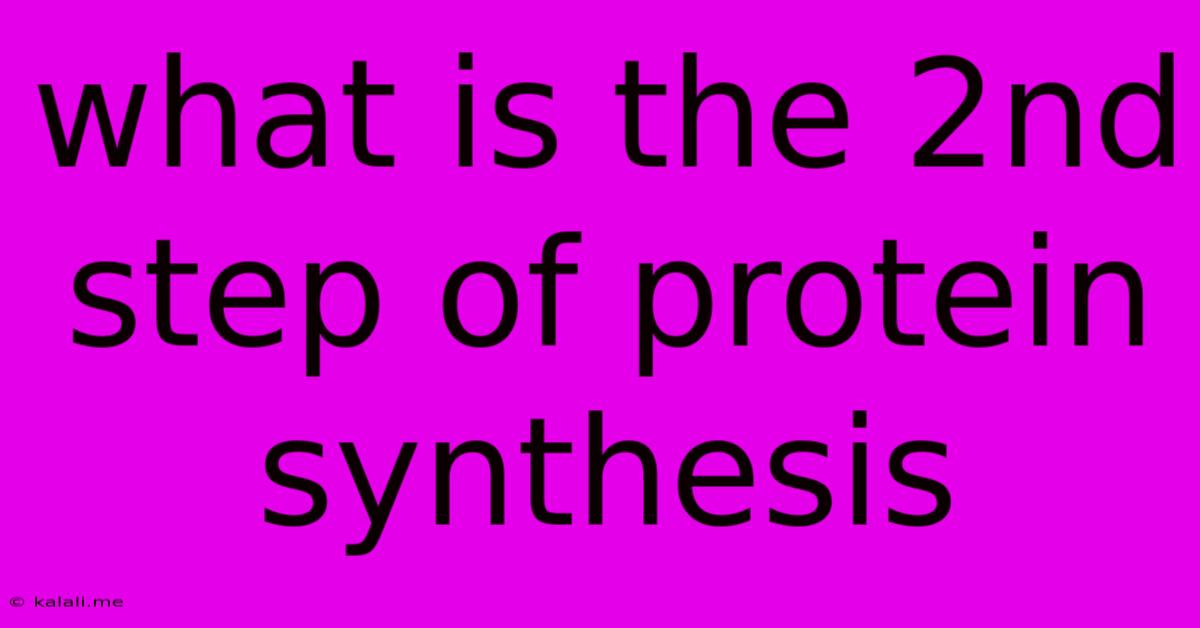What Is The 2nd Step Of Protein Synthesis
Kalali
May 09, 2025 · 3 min read

Table of Contents
What is the 2nd Step of Protein Synthesis? Understanding Elongation
Protein synthesis, the process of creating proteins from genetic information, is a fundamental process for life. It's a two-step process: transcription and translation. While transcription creates the messenger RNA (mRNA) molecule, the second step, elongation, is the crucial part of translation where the polypeptide chain, the building block of a protein, is actually synthesized. This article delves into the intricacies of elongation, explaining the mechanisms and key players involved.
Understanding elongation is key to grasping the complexities of protein synthesis, a topic vital for biology students, researchers, and anyone fascinated by the machinery of life. This detailed explanation will cover the process step-by-step, highlighting the roles of tRNA, ribosomes, and other essential molecules.
The Elongation Process: A Step-by-Step Guide
Elongation, the second stage of translation, builds the polypeptide chain amino acid by amino acid. This process occurs in three main steps:
-
Codon Recognition: The ribosome moves along the mRNA molecule, exposing the next codon (a three-nucleotide sequence specifying a particular amino acid). A specific transfer RNA (tRNA) molecule, carrying an anticodon complementary to the exposed codon and carrying the corresponding amino acid, enters the A site (aminoacyl site) of the ribosome. This process requires energy provided by GTP (guanosine triphosphate). Accuracy in codon recognition is critical; incorrect pairing leads to errors in the protein sequence.
-
Peptide Bond Formation: Once the correct tRNA is in the A site, the ribosome catalyzes the formation of a peptide bond between the amino acid carried by the tRNA in the A site and the growing polypeptide chain attached to the tRNA in the P site (peptidyl site). This reaction is facilitated by peptidyl transferase, an enzymatic activity of the ribosomal RNA (rRNA). The newly formed peptide bond links the amino acids together, extending the polypeptide chain.
-
Translocation: After peptide bond formation, the ribosome moves one codon along the mRNA. This movement shifts the tRNA carrying the growing polypeptide chain from the A site to the P site, and the empty tRNA in the P site moves to the E site (exit site) and is released. This translocation requires energy supplied by GTP, ensuring the ribosome progresses efficiently along the mRNA template.
Key Players in Elongation
Several key players are crucial for the successful completion of elongation:
- mRNA: This molecule carries the genetic code that dictates the amino acid sequence of the protein.
- tRNA: These molecules act as adaptors, carrying specific amino acids to the ribosome based on the codon sequence. Each tRNA has an anticodon that base-pairs with a specific codon on the mRNA.
- Ribosomes: These complex structures act as the workbench for protein synthesis. They bind to mRNA, facilitate tRNA binding, and catalyze peptide bond formation. Ribosomes are composed of ribosomal RNA (rRNA) and proteins.
- GTP: This energy-rich molecule provides the energy required for various steps in elongation, such as codon recognition and translocation.
- Aminoacyl-tRNA synthetases: These enzymes attach the correct amino acid to its corresponding tRNA molecule. Accuracy in this step is crucial for preventing errors in protein synthesis.
Elongation: A Dynamic Process Crucial for Life
The elongation phase of protein synthesis is a highly dynamic and coordinated process, requiring precise interactions between mRNA, tRNA, ribosomes, and various enzymes. The accuracy of this process is essential for creating functional proteins. Errors in elongation can lead to non-functional or misfolded proteins, potentially causing diseases. Further research continues to unravel the intricate details of this vital biological mechanism, deepening our understanding of life itself.
Latest Posts
Latest Posts
-
What Fraction Is Equivalent To 1 2
Jul 13, 2025
-
What Is The Average Iq For A 9 Year Old
Jul 13, 2025
-
How Long Does It Take For Brandy Melville To Ship
Jul 13, 2025
-
How Many Times Does 3 Go Into 30
Jul 13, 2025
-
In What Episode Of Bleach Does Ichigo Ask Orihime Out
Jul 13, 2025
Related Post
Thank you for visiting our website which covers about What Is The 2nd Step Of Protein Synthesis . We hope the information provided has been useful to you. Feel free to contact us if you have any questions or need further assistance. See you next time and don't miss to bookmark.